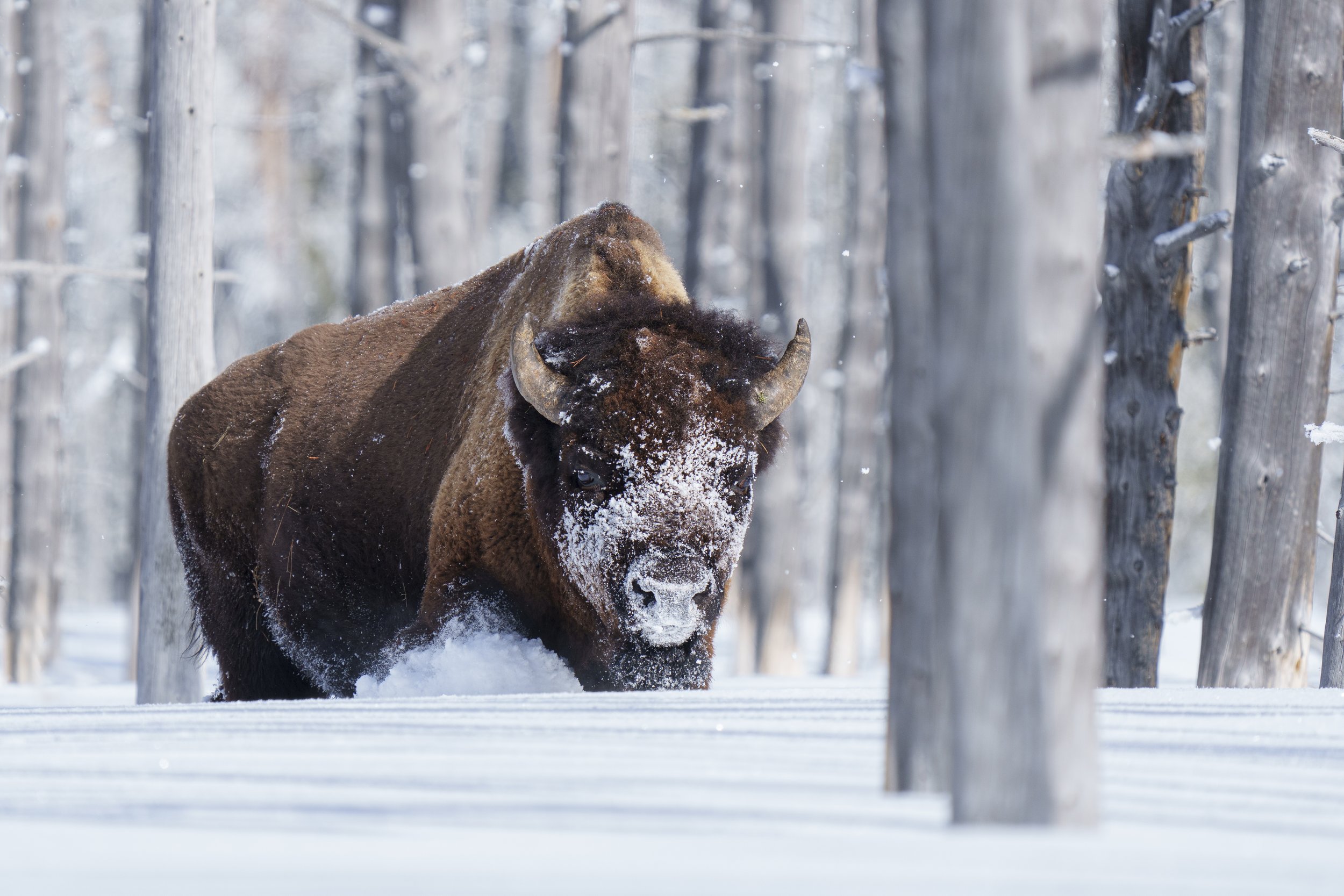Chasing the Rut pt 2
Although the bison rut is something every wildlife photographer should have the opportunity to experience, my preference is to photograph these thunder beasts in the winter instead.
In last week’s email, I explained that I was going to share something of a primer on photographing the rut in North America - covering all of the major species except for caribou, muskox, and Dall sheep.
In this article I begin to dive into the first species that goes into the “rut” for the year: bison.
Before we can talk about these animals, however, I feel the need to get something straight. They are not, and should never be confused with, buffalo. There it is. I feel better already. This is one of those things that tends to drive me crazy. Bison are not buffalo. Your ancestors got it all wrong. Yes, I realize we have the buffalo nickel and Buffalo New York and Buffalo Bill Cody and even the buffalo burger. But just because people keep saying the same wrong thing over and over again doesn’t make it right. Buffalo do not live in North America. Buffalo live in Africa (cape buffalo) and Asia (water buffalo). Bison are quite different. Deal with it and let’s move on.
Bison are the first species in North America to kick off the annual rut. Come August, things are really starting to heat up for this species. Most of the year, cows and bulls remain separated. When you travel to Yellowstone at any other time of the year, those great and vast herds of animals you see are primarily cows, calves (red dogs), and teenagers of both sexes. Though you may see a few bull bison in the herds wandering about, the real contenders, the breeding bulls, are off on their own and do not begin to make an appearance again until August.
Bull bison are like most ungulates (hoofed mammals). They tend to separate themselves by sex most of the year. The females hang together in massive herds. The large breeding bulls, on the other hand, either go it alone or group up in very small bachelor herds. And for the really big and dominant bulls, you tend to find them either solitary or with one or two other similarly sized brutes.
Then the rut happens. The hormones start flowing. And like bull elephants in musth, suddenly these great thunder beasts begin to emerge from the ether, drunk on testosterone, full of spit and swagger, sauntering back to the herds in August.
Of all the calves that are sired each year within any given herd, typically 1 single bull bison is responsible for a solid 50% of all those babies. Very few bison actually get the opportunity to mate each year, and many bulls will live and die without ever having the chance.
Typically, a bull bison will first begin attending a female he is interested in. If he is lucky enough to mate with her, then he will continue to follow her around for a few days to ensure no one else has the opportunity to and hopefully secure is genetic line for the year.
But success or failure here all depends on whether or not a cow is interested – and they have a really clever way of getting rid of unwanted attention.
If a cow communicates that she is not interested but the bull persists, she simply takes off running through the middle of the herd. The unwanted male tries to keep up. But in the process both cow and bull draw the attention of every other male that has come to breed.
Since bison are a tournament species – meaning they fight for the right to hangout with the ladies – the other large bulls immediately rush in and surround the other bull that the cow is trying to get rid of.
From the other bull bison’s perspective, this is their chance to show fleeing cow that they are bigger and better and meaner than her annoying suitor is. And if that suitor wants to keep after the cow, then he is forced to battle every single bull that has circled him first.
For the cow, the problem is solved.
For the wildlife photographer, if you recognize this behavior, if you see this beginning to unfold, you can get into position and photograph one fight after another as the suitor battles his way out of the ring.
Wherever bison live, they are always the most dangerous animal around. More people are injured by bison in places like Yellowstone than all other species combined. Bears? Eh, the chance is infinitesimally small unless you doing something stupid like try to take a selfie with a mother grizzly and her two cubs. In fact, the National Park Service says you have a 1 in 2.2 million chance of being injured by a bear – which, for the record, you have a 1 in 250,000 chance of being injured by a meteorite or some other space junk falling to Earth. Wolves? No threat what so ever.
The problem with bison is that they tend to be where a lot of people want to be – places like Old Faithful for instance. And for some reason that I still cannot wrap my brain around, we long ago outlawed natural selection of our own species. Thus, when you stick 5 million people, for which we can say probably 90% are not the sharpest crayon in the box, around 2,000lbs wild bison, people get hurt. They get gored. They get tossed into the trees like rag-dolls. And it always ends up on YouTube.
Bison are like every animal on the planet I have ever spent time around. They really just want to mind their own business. They want to respectfully tend to their own lives. And when you begin to do something they are not keen on, they do everything in their power to communicate that with you long before anything goes sideways.
When I say that they are like every animal I have worked with in this sense, I mean it. Whether bison, bear, snake, or crocodile – everybody tries to communicate with us to the best of our ability. Other animals are paying attention. Other animals know what it all means – even if they are not familiar with bison or crocodiles. But us humans on the other hand seem to be so far removed from the natural world these days that we stand around with slap happy smiles on our faces, cell phones in hand, taking selfies to our own graves.
So, what does a bison do to tell you their uncomfortable? They stick their tales in the air. Simple as that.
There are a few other cues, but for the uninitiated, this is the big one you want to watch for. When a bison raises its tail in the air, this means one of two things is imminent: either a charge, or a discharge. Either way, you need to back up.
When it comes to photographing the bison rut, keep in mind the atmosphere. And, by atmosphere I mean all the stuff in the air around them. The bison rut comes at a time when things are very dry and very dusty in the West. When these brutes start banging heads, they can really kick up great clouds of dust around them. Shot with frontal lighting, all of this dust in the air will be lost to the other details of the photograph. With extreme side lighting or back lighting however, you will be able to take advantage of all the dust by making it a compositional element unto itself.
Personally, I prefer to photograph bison in the winter versus the summer. Watching these bulls bang heads is an extraordinary thing to witness. But it’s the white canvas of winter that is the most appealing for my artistic tastes.
Locations . . .
Badlands National Park and Wind Cave National Park
I am grouping these two parks together because of how close they are to each other. If you’re going to travel to Badlands National Park for wildlife, and believe it or not, this place is an awesome place to be for wildlife, then you might as well check out Wind Cave as well. They are roughly 70 miles from each other. Which, by Western standards, is about the distance one would be willing to travel for a good cup of coffee. Both of these national parks can be found in the state of South Dakota and hold healthy populations of bison.
I prefer these national parks over Yellowstone for bison due to the lack of people. The visitors are not there specifically for wildlife. And there is a very good chance you will be the only wildlife photographer you see prowling about in search of images.
The National Bison Range
As the name implies, this place is all about the bison. This is a National Wildlife Refuge that caters specifically to these animals. The topography is rolling and high prairie. There are loads of bison. And you will have the world to yourself as a photographer.
The National Bison Range is located between Missoula and Kalispell, Montana. This is great place, off the beaten path, and the rut here is legendary.
Yellowstone National Park
I’m sure this is an obvious place to most. Yellowstone National Park was critical in bringing this species back from the edge of extinction and today everyone associates this is the place with bison – especially Hayden and the Lamar Valley. Me, I steer clear of Yellowstone these days except for January, February, May, and late October. All these months have something special to offer me, and they also happen to be times with some of the lowest visitation in the park. For the bison rut, however, which occurs in August, which occurs during peak tourist season, I travel elsewhere.

